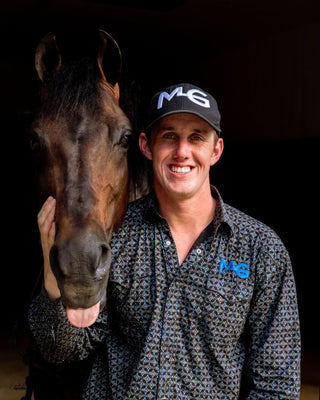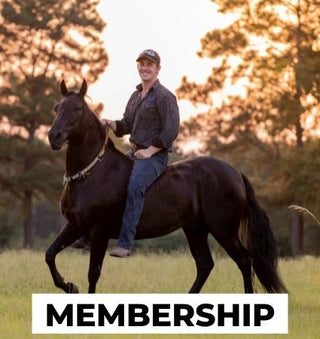Watch the Video Here or continue reading below!
Training for softness, focus, and control—starting with the horse’s head
When it comes to horsemanship, one foundational truth stands out: control the head, control the horse. In this post, we’ll explore how teaching your horse to lower its head can transform their behavior, boost your control in the saddle, and set the stage for a relaxed, responsive riding partner.
With the help of Thunder, a Friesian-Arabian cross with a background in classical training, Michael Gascon demonstrates how to use tools like the German martingale to teach a horse to drop its head—and keep it there—even at higher speeds.
Why Head Position Matters
A high head equals a high motor
Thunder came to us full of adrenaline. His head was constantly elevated, which meant his motor was always on. This led to him bolting, running through handlers, and generally being unpredictable. Many horses with this behavior pattern are simply missing the opportunity to feel calm and secure—starting with their head position.
Did you know?
When a horse drops its head below the withers, it releases an endorphin that helps reduce adrenaline. This simple shift can be the key to unlocking a more relaxed horse.
Introducing the German Martingale
A tool to teach softness and self-carriage
To help Thunder understand where we want his head, we used a German martingale. This piece of tack is an effective training aid when used correctly. It combines split reins with a draw rein system that helps create a natural, downward draw when rein pressure is applied.
Key Features of the German Martingale:
-
Reinforce head position with light pressure
-
Allow flexibility for the rider to release
-
Help correct head carriage without constant rein tension
Pro Tip:
Set your martingale snug enough to create a boundary, but loose enough for your horse to find the release when softening.
Groundwork First: Introducing New Equipment
Always start from the ground
Before ever climbing into the saddle with new tack, go back to basics. Groundwork allows your horse to explore the feel of new equipment and understand your expectations without the added complexity of a rider.
With Thunder, we walked circles using the reins attached through the martingale, checking his steering and ensuring there was no adverse reaction.
First Ride: Reinforcing the Draw
Let the draw rein teach before your hands do
Once in the saddle, it’s time to reinforce what the martingale is communicating: keep your head low. We checked the steering wheel first by asking for lateral flexion. This ensures that if the horse spooks or bolts, we can disengage and redirect, instead of getting pulled forward.
Why the Martingale Helps Real Riders
It corrects our natural mistakes
When riding in a snaffle alone, riders need perfect timing and low hands. But when instinct causes us to raise our hands in a moment of tension, the German martingale still draws the horse’s head down. It becomes a safety net for imperfect timing and helps keep the message clear.
Step-by-Step: Building Speed Without Losing Control
Walk → Trot → Canter with consistency
We never want to let the horse pop their head up as they go forward—this builds resistance. Instead, we establish the head-down position first, and maintain it throughout transitions.
If the horse tries to raise their head, we use light, lateral pressure to bend them and bring them back to softness.
Watch for the Release
Ride with feel, reward with timing
Every time Thunder kept his head down, he felt a release of pressure. Every time he raised it, he felt the reins engage. He learned through feel, and our job was to time those releases perfectly.
“Touch and release. Touch and release. That’s where the learning happens.”
Common Mistakes to Avoid
Don’t let your horse lean on the martingale
The German martingale is a training aid, not a crutch. If your horse starts leaning or bracing into the reins, it's a sign you're holding too long or too hard. Keep your cues light, brief, and intentional.
Two Game-Changing Tips
1. Sit Back to Bring the Head Down
When you sit deep and exaggeratedly back in the saddle, you shift the weight onto the horse’s hindquarters. This naturally elevates the withers, which encourages the horse’s head to lower.
2. Melt into the Downward Transition
When the horse gives you their head, melt through your seat and shoulders to reinforce relaxation. Combine this with a release of your leg pressure, and your horse learns to associate softness with slowing down.
It’s Not Just About Head Position
Lowering the head unlocks everything else
Getting the horse's head down is the start of better body control, better stops, and better responsiveness. Thunder went from spooky and high-headed to calm, collected, and focused—all in a few weeks of consistent training.
“If you can’t control the horse’s head, you can’t control the body. Head control is body control.”
Final Thought: Head Down = Brain Off
Use this method to calm adrenaline and unlock focus
Whether you're trail riding, working cattle, or tuning up your dressage mount, a soft, low head means a quiet, attentive mind. Every time you ride with this principle in mind, you're building a more rideable, responsive, and safe horse.









